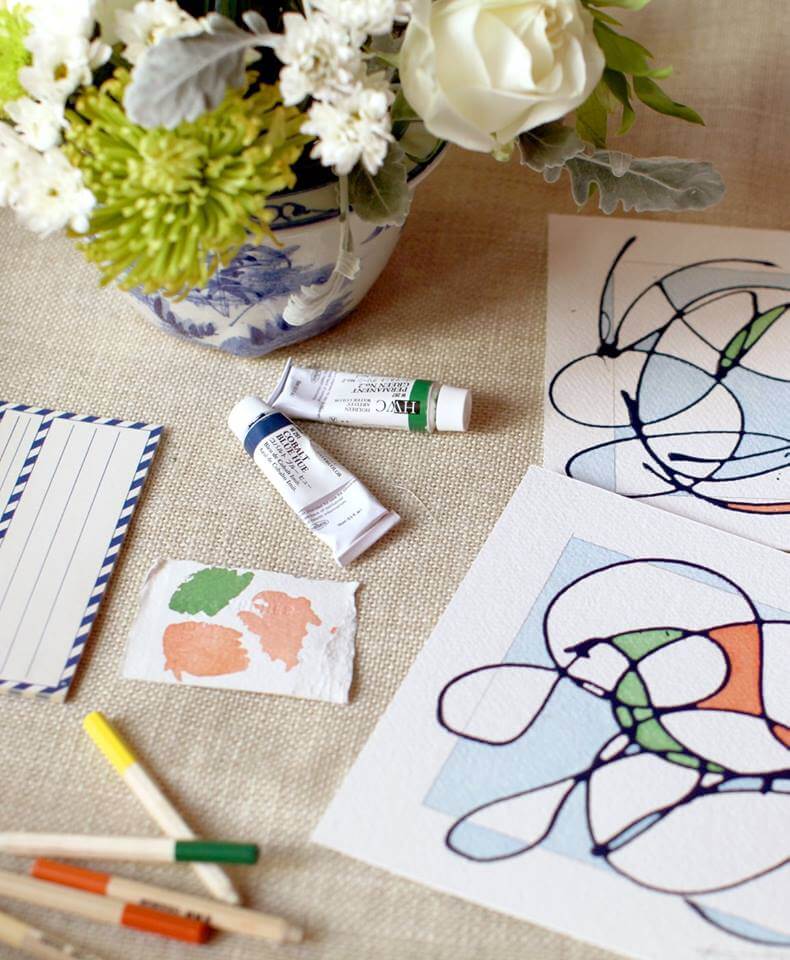Living An Artful Life: Nashville Painter Kayce Hughes
The rooms we live in tell our stories. A rich-blue rug picked up on a spontaneous trip to Turkey with a ex-boyfriend a thousand years ago; a line of tchotchkes on a mantlepiece, each one possessing the capability, with one touch, to transport you back to the flea market stalls where you bought them. The past often comes to us through these inherently nostalgic objects—and when it comes to the art in which we line our walls, the presence of the past is even more palpable.Nashville artistKayce Hughes doesn’t take that responsibility lightly. She came to her art practice after a successful career in women's and children’s fashion, during which she designed staple wardrobe pieces for her patrons: a bright-pink statement dress to feel brave, the perfect red coat for protection. But her heart was always in art-making, and, more specifically, in making the kind of art that patrons love so much that the pieces become imbued with new meaning.We sat down with Hughes to discuss starting a new career, creating a brand while raising seven children, and recreating the serendipitous experience of stumbling upon a fabulous antique and building a whole room around it.Tell me a little bit about your background before you embarked on your career as a painter last year. Have you always wanted to be an artist?I was a studio art major in college, so fine art is sort of what I did a million years ago. I really didn’t do much with it for years, other than stuff for my own walls. I ended up working for Ralph Lauren when I graduated, and eventually I had three clothing stores of my own in Atlanta, Chattanooga and Nashville. I’d make a giant painting for behind the cash wrap, and started selling a teeny bit in the stores. It wasn’t really something I promoted until probably two years ago, and even then, it wasn’t my full-time career for a while.Looks like that changed fairly quickly; you sold your clothing company, and the level of success you’ve had since is really amazing. What’s something that you think has distinguished your work in the wide field of fine art?One of the things that might make me a little bit different is that I love working with decorators. I do believe that designing and decorating is an art form in and of itself; I notice in my own home that if I put the wrong painting in the wrong spot, even if it’s a gorgeous painting and a gorgeous spot, it can look horrible. Certain places need a framed canvas rather than a paper piece. The size, how you frame something, how all of those little decisions work together to create an amazing room—I’m in awe of what decorators do. For some artists, the feel is, 'I’m just going to create my art, I’m not going to talk to a decorator about what color the couch is,' but I actually love that part.There’s something about your work that feels intensely personal and human—and even when your paintings are at their most composed. You don't hide the brush strokes or conceal the process by which a piece was made. Some of your paintings have the feel of paint swatches on a wall, or wax seals on a letter, and you’ve talked about your love of handwriting and how that influences pieces, like those in your "Love Notes" series. Do you think that attraction to personality and the human touch is part of why you’re compelled to make paintings specifically for rooms that 'real' people live in?You know, I hadn’t thought about it quite that way, but yeah. I do feel that rooms are meant to be lived in, and I love when things in a room tell a story. Whether it’s a little girl’s room, [or] it’s a room for a 24-year-old who used to live in Paris, [or] it’s an 80-year-old couple’s much-loved home, a room has to have layers. You can’t just go buy all new furniture and expect [the room] to tell a story. A great designer has new pieces mixed with old pieces mixed with more personal stuff; if it all looks like it came from West Elm, that doesn’t work. I want my paintings to feel like, 'Oh, my gosh, I found this in a vintage store and it just happened to look great with this fabric.' I’m always asking myself, 'How can I create something that looks like you stumbled upon it?'You’re the mother of seven children, and you were the oldest of six children yourself. I can imagine that’s part of why having a room of your own that says something about who you are is really important to you.[Laughs] For sure. Though, of course, my kids don’t all have their own rooms. The oldest three are in college, and the fourth-oldest is a [high school] senior this year, and he gets his own space. So, of course the rest of them are all jockeying for it—they’re all like, 'When Owen graduates, his room is mine, right?'But really, I think I’ve always loved spaces. For certain kids, it’s really important what their room looks like and feels like. My habitat was always my number-one thing that I loved, more than traveling or eating great food, or even what I wore. [When I was] a college student, my mother had an antique store, and I worked with her and helped out as a buyer and then saved up all my money to buy it right back. I guess that’s not normal for an 18-year-old. [Laughs.]Your aunt was the infamous designer Lilly Pulitzer. Has her aesthetic or her personality influenced your fashion—or, now, your art?She really has a personality that was beyond amazing. Anyone who spent more than five minutes with her would feel her impact. The way she decorated her home, the way she invited everyone she ever met to her house for a giant supper and managed to feed absolutely everybody—I hope I absorbed just a tiny bit of her love for things that are colorful and beautiful and fabulous. But she also thought nothing was ever as important as hanging out and having a wonderful conversation, and I hope I’ve absorbed some of that, too.That’s so clear just from talking to you. And also from looking at your work—with all the things you’re balancing, from motherhood to a transition to a booming new career, it’s amazing that your paintings feel so clean and clear—almost like someone’s speaking to you. How do you occupy that balance point between always doing more and making space for the people and objects that really matter?I think honestly, creatively, or in life, that’s the kind of yin and yang, the push and pull you’re looking for. It’s probably easier if you’re at one of the two extremes, where you’re either a total minimalist or you’re very happy with hoarding and excess. But, for me, I’ve never been that way. I mean, the temptation to do more is always there—I was working for Ralph Lauren during the '90s, which was this total more-is-more era. And I’m also sort of a hunter-gatherer by nature: I’m always going to the thrift store and buying another set of champagne flutes. But you get to a point where you’re like, 'I’m not going to arrive there where I have absolutely everything.' I’m going to enjoy the process and recognize that sometimes life is about gathering, and sometimes life is about cleaning out.Photography courtesy of Kayce Hughes

